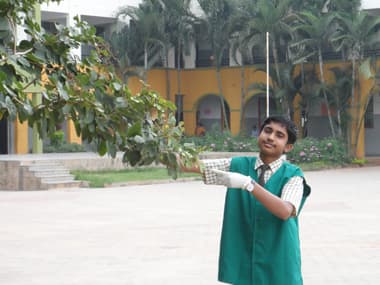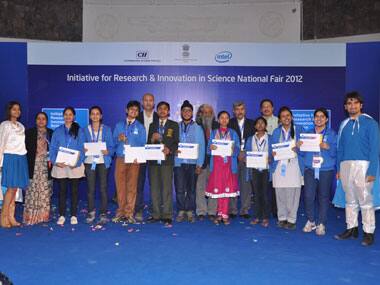New Delhi: The 19th Century French chemist, Louis Pasteur- also regarded as one of the founders of microbiology and pioneer of the ‘germ theory of disease’ - once said, “Let me tell you the secret that has led me to my goal. My strength lies solely in my tenacity. "
Fifteen-year-old M. Yeshwanth from Hoskota, a small town on the outskirts of Bangalore, idolises him. So much so, that picking up from Pasteur’s ethos of perseverance and trying his hand at the Initiative for Research & Innovation in Science (IRIS) Award thrice before, Yeshwanth finally made it on the grand prize winner list this year.
IRIS , which recognises innovators in research and gives them a larger platform to share and showcase their project, is one of India’s largest science initiative for students. This year, of the over 2,000 submissions across 17 categories received by IRIS, 111 were shortlisted to the finals. Of those projects, seven were chosen as grand winners, with Yeshwant’s being one among them. The winners of the competition will represent India at the annual Intel International Science and Engineering Fair (Intel ISEF), to be held in Arizona, US, in May 2013.
“I am just a normal boy interested in and curious about things around me. There have been things I have worked on, which didn’t work out - and I have even cried about it many times. But, I think disappointments have made me what I am today. They egged me on, I didn’t give up and success now tastes much better,” the class 10 student of Citizen’s High School told Firstpost.
But, Yeshwanth’s journey from a small rural town on the outskirts of Bangalore to Arizona, where his research innovation will compete with the best in the world, has been anything but easy.
Impact Shorts
More Shorts[caption id=“attachment_566423” align=“alignleft” width=“380”]
 Yashwanth’s journey from a small rural town on the outskirts of Bangalore to Arizona, where his research innovation will compete with the best in the world, has been anything but easy. Image courtesy: M. Yeshwanth[/caption]
Yashwanth’s journey from a small rural town on the outskirts of Bangalore to Arizona, where his research innovation will compete with the best in the world, has been anything but easy. Image courtesy: M. Yeshwanth[/caption]
THE BEGINNINGS
The first-born in a lower middle class, but educated family, Yeshwanth’s desire to become an innovator preceded his love and interest in Science. In his own words, he was “a very average student who had a very normal student life of being bullied and being mediocre”. But, a chance reading of the names and news of Nobel Laureates in a magazine, when he was in class four, sparked in him a desire to be like them. “I thought, if I too become a scientist or a great person, my name and photo will also come in papers and magazines. My parents will be so proud of me,” he said. It was then that his drive to be an innovator was spurred.
Yeshwanth said he then began taking a more active interest in his general studies triggered by his newfound desire to succeed and become a “somebody”.
The following year, during an educational trip to Bangalore’s Jawaharlal Nehru Planetarium, Yeshwanth’s curiosity in Science was roused and he found focus. There, inspired by an invigorating explanation by the head of the planetarium – about stars, planets, their life and formation, the solar system and the big bang theory – he decided that he wanted to become a “somebody” in Science.
“That speech interested me a lot. It was the first time I heard about the Big Bang Theory and I was fascinated. When I came back to my school, we were asked about our experience. I raised my hand and narrated everything that the head of the planetarium told us. After I finished, my teacher and classmates applauded me,” he said, getting his first sliver of success. Then on, he took special interest in the Sciences and excelled at them.
THE INNOVATOR
In class six, at the age of 11, Yeshwanth designed a solar battery for a car. In 2008, he designed an air pressure combustion engine (one which runs with air pressure). Every year after that, too, Yeshwanth made it his aim to innovate on at least one thing each year and for the past four years he has been applying for the IRIS.
His winning research project this year was the discovery of an anti-bacterial property in the leaves of the Bauhinia Purpuria plant, also known as Purple Camel’s foot - something which can possibly be used in a medicine for bacteria that causes brain and heart diseases.
“Till today for that particular bacteria, there is still no medicine or immunisation. But in my research I found a dosage for the bacteria which may be workable,” Yeshwanth said.
Eswaraiah G, mentor and former professor to Yeshwanth, describes him as “a very involved student, full of ideas and very open minded”. He says he has no doubt that Yeshwanth will succeed.
“He always showed a lot of interest in discovering and inventing something and has a lot of drive to become an inventor and a scientist. His best traits are that he is sharp, curious, humble, determined and very persistent. He is not pulled down by failure,” said Eswaraiah, who taught Yeshwanth Biology and Chemistry for three years.
Explaining Yeshwant’s research, he said, “There’s no medicine for the bacteria micrococcus lutes – which causes meningitis, endocarchritis other cerebrum diseases. In the preliminary tests of the leaf properties, we have found positive results. We now need to conduct further tests on it.”
While Eswaraiah guided Yeshwanth, he told Firstpost that the discovery was a result of Yeshwanth’s own hard work, despite the hurdles.
[caption id=“attachment_566427” align=“alignleft” width=“380”]
 The 10 students who will be going to Arizona next year to showcase their research projects . Picture courtesy: Intel IRIS 2012[/caption]
The 10 students who will be going to Arizona next year to showcase their research projects . Picture courtesy: Intel IRIS 2012[/caption]
HURDLES AS A STEPPING STONE
While Yeshwanth’s father is a mechanical engineer and his mother a teacher, his family is lower middle class. So even though his parents were supportive of him and encouraged his scientific temper, resources were few, Yeshwanth said.
“Many of my expenses for research were taken care of by my school and its principal in terms of providing the school lab - especially after school hours, in providing the instruments and chemicals needed for testing and also in guidance. But, my family too incurred expenses like traveling to Bangalore’s Electronic City for advanced experiments and paying for things like the numerous printouts on special sheets of plastic I had to make for this project,” he said.
In most instances, Yeshwanth said, technological facilities in Hoskote were scarce and poor, so his father often took absence of leave to accompany him to the lab in Bangalore and to procure inventory for his project.
“My father would take leave for me, but there were times when he couldn’t. We are not rich and so he could not afford to miss work too much. In times like these, I just had to wait till my father had time and accompanied me to the city because my parents wouldn’t allow me to go there alone,” he said, “As it is things in the city were expensive – if a normal print out of my papers would cost about Rs. 250-300, the special printing on plastic sheets cost my father more than Rs. 1,000.”
“My parents always encouraged me, even if they didn’t have too much money to spare. Whenever I lost, they said there would be a time I would overcome and win,” he said.
While encouragement was generous, facilities were insufficient for the class 10 boy to conduct his research without hurdles. Laboratory facilities in his school, while basic, was not enough after preliminary tests on the leaf. And so, on the suggestion of his mentor Eswaraiah and Dr. Harish Bhat, scientist at the Indian Institute of Science in Bangalore, Yeshwant took his work to a lab in Electronic City.
“The school management supported the project as much as they could, but after preliminary tests, we had to move to a lab in Bangalore - which specialised in R&D and quality control for life sciences - for further bacteria culture and incubation. The lab was kind enough to allow Yeshwanth to use their facilities for free,” Eswaraiah said.
On an infrastructure level, constant powercuts was a huge challenge.
“We don’t have reliable electric supply in our town and we see long hours of no power almost everyday of the week. There have been many times I have worked in school without electricity and then come back home and written my research notes under candlelight. Most times, the candle was my savior,” Yeshwanth said.
Emboding the true spirit of his idols Louis Pasteur, Swami Vivekanand and APJ Abdul Kalam, Yeshwanth follows the principles of doggedness, humility and hardwork – because he says, “I want to become like each one of them.”
“I am not such a talented boy. I am just curious and hardworking. I am just normal. My goal is to become a scientist so that I can discover something that will be beneficial for society,” he asserts.
Yeshwanth, however, considers his mentor as the most important link in his success.
“He was the person who shared with me all his knowledge - he was truly a mentor, guide and a best friend. It’s like a Diwali rocket you know, I’m like the the carbon inside which is capable of combustion and thrust, but without the spark – which is Eswaraiahji - I wouldn’t be able to propel and soar into the sky,” Yeshwant said of his mentor.
)